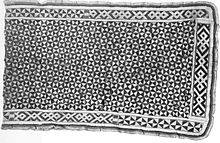Kuba art
Such work often featured decorations, incorporating cowrie shells and animal skins (especially leopard) as symbols of wealth, prestige and power.
The Kuba produce embroidered raffia textiles which in the past was made for adornment, woven currency, or as tributary goods for funerals and other seminal occasions.
[2] Kuba was a multicultural kingdom in Central Africa, which developed during the early seventeenth century and reached its peak in the second half of the nineteenth.
Headdresses are designed to call attention to the head as the source of divine power, and are worn at dances, funerals, and other major communal ceremonies.
Cotton cloth, cowrie shell, raffia fiber, wood, and glass beads are commonly used materials in the creation of various headdresses.
Surface decoration that cover these vessels and boxes are known as nnaam, a Kuba term referring to the tangled vines and creepers that grow in the fertile forests of this region.



